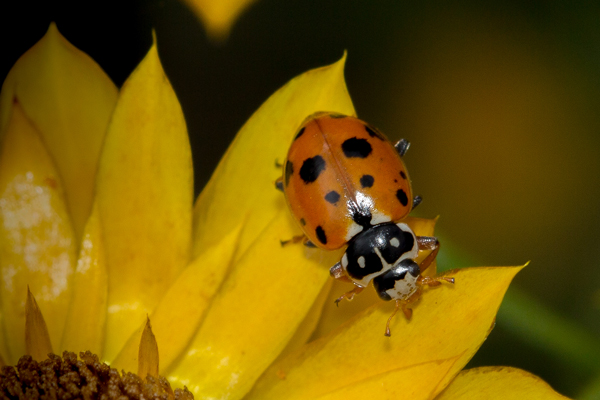By Karen Retra
Did you know there are about 500 species of ladybird beetles in Australia?
Of these, I regularly see five species in my garden.
Ladybird beetles (Coccinellidae family) are terrific pest controllers. For many species, both the larvae and adults feed on small, soft-bodied and sap-sucking insects like aphids, scales and mites. Maybe you’ve seen the yellow, fungus-eating ladybirds, Illeis galbula, that move in when mildew appears on plant leaves and help by hoovering it up.
Yet some gardeners are quick to warn that there are ‘dangerous’ ladybird beetles, too. They are usually referring to the several species of leaf-eating ladybirds found in Australia. You might know them as the 28-spotted or potato ladybird.
These species eat leaves of plants, particularly zucchini, cucumber, pumpkins, beans and potatoes. In large numbers they can kill seedlings and impact plants’ growth or yields.
But in home gardens we needn’t be terrified, nor rush to exterminate ladybird beetles. The presence of a couple of these ladybirds, or a little munching, won’t severely impact the plant nor your harvest.
If you are concerned, try these four tips for assessing and responding.
- Observation is key. Is there damage? Can you live with that level of damage? Are you sure it’s ladybirds causing any damage you’ve noticed?
- Be sure you can identify those causing the damage, and not wipe out a bunch of your garden allies. Despite their common name, noticing ‘lots of spots’ isn’t a great way to identify these beetles. Other similar looking beetles are regularly mistaken as ’28-spotted’ as they too have many spots, are similar colours or similar size. Look closely. The plant-eating beetles have short, downy hairs on their upper surface, giving them a duller appearance than their shiny, insect- and fungus-eating relatives.
- If you do act, target only the ladybirds causing the damage. Sprays (whether commercial or homemade) will wipe out all insects, not only ‘bad guys’. Try squashing individual beetles and larvae or drop them into soapy water.
- Deter plant-eating ladybirds with other garden practices. Nightshade weeds often host plant-eating ladybirds, so remove them. Also, plant-eating ladybirds prefer stressed plants, so feed your vegetables and keep the water up.
There’s a lot to love about ladybird beetles. Unless you’re a small, sap-sucking insect, I guess.

